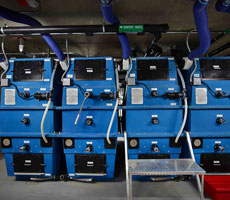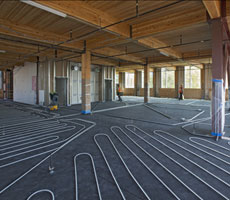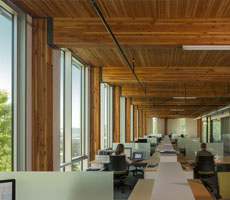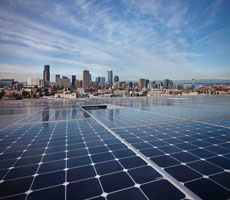The goal of the Bullitt Center is to drive change in the marketplace faster and further by showing what’s possible today. The Bullitt Center was designed to show what’s possible today, changing the way people think about high performance green building. While the building includes many innovations, in reality every feature of the building is being used elsewhere in the world. However few, if any, projects have managed to put together so many systems, design features and construction techniques.
Following are just some of the key features of this remarkable building.
WARMTH FROM BELOW
Spaces are heated with warm water circulated in tubes embedded in concrete floor plates.
- 26 closed-loop wells take a mixture of water and glycol 400 feet down into the earth
- The baseline ground temperature is 53 degrees
SUSTAINABLE CITY SERVICES
Dense, diverse neighborhoods encourage walking, bicycling and transit.
- There are 20+ bus routes, a streetcar (in 2014) and lightrail (in 2016) within 1/2 mile
- There are 20+ Zipcars and Car2Go within 1/2 mile
- The Bullitt Center’s location has a walk score of 99/100
ZERO NET ENERGY
Net zero energy is possible, even in Seattle.
- Connected to the grid, where excess power is stored
- One meter measures energy sold to Seattle City Light, one measures energy purchased
COMPUTER CONTROLLED SYSTEMS
Computers automatically adjust passive and active systems to keep the building comfortable and efficient.
- Like the brain, the systems help the building respond to and interact with the environment
- Controls include Heating/Cooling, Passive/Mechanical Ventilation, daylighting and metabolic systems
WATERLESS WASTE
Extremely low-flow toilets reduce water use.
- Toilets use only two tablespoons of water mixed with biodegradable soap to foam the bowl.
- Toilets and urinals return air to the aerobic composters.

COMPOSTING WASTE
The world’s only six-story composting toilet system.
- Human waste is transferred to composters and periodically taken offsite to be used as fertilizer.
- Aerobic digestion heats material to 190 degrees and converts solid waste to compost.
WASTEWATER USE
The project reconnects the hydrologic cycle by infiltrating clean water back into the ground.
- Water from sinks and showers is stored in a greywater tank and cleaned in a constructed wetland.
- Clean greywater is infiltrated back into the soil to recharge the local aquifer.
RETURNING WATER WORKS
Like a Doug fir forest, the Bullitt Center returns water to the soil and atmosphere.
- The building will restore the historical relationship of water to the land by collecting rain, returning it to the earth and the atmosphere.
- 61% of the water in a Douglas fir forest evaporates or infiltrates into the ground, similar to the grey-water treatment in the Bullitt Center.
A REGENERATIVE LIFT
Regenerative technology increases efficiency of the KONE elevator.
- A prominent and beautiful stairway encourages stair use.
- The fully ADA-compliant elevator uses a “Regenerator” system to convert kinetic energy from braking into useable electricity, saving 60% of typical electrical use.

EXTREME HEATING EFFICIENCY
Ground-source heat pump and in-floor radiant system heat the building extremely efficiently.
- Heat pump converts 53° water from underground tubes to 95° for heating the building.
- Heat pump uses a compressor to extract heat and increase temperature in the radiant heat system.
ACTIVE DESIGN
Building design encourages physical activity to reduce energy use and improve health.
- To promote human health, occupants of the building are greeted with an inviting stairway with views of downtown Seattle and Puget Sound
- The average adult will burn 3,900 calories over the course of a year by taking the stairs, equal to a pound of weight gain.

TALL TIMBERS REDUCE THE CARBON FOOTPRINT
FSC-certified heavy timber structure reduces carbon footprint and adds to beauty of the building interiors.
- Forest Stewardship Council Certified timber framing supports the building above a concrete base.
- All wood from within 1000 km, all steel and concrete from within 500 km.
545 metric tons of CO2 are sequestered in the wood.
WETLAND FILTERS
Constructed wetland filters greywater before it is infiltrated back into the soil.
- Wastewater filters through the constructed wetland so plants can absorb the organic matter.
- Up to 500 gallons can be filtered per day.

A BROAD CANOPY ARRAY
The PV array generates as much electricity as the Bullitt Center uses in a year.
- The photovoltaic array spreads out like the canopy of a tree to capture solar power for the building.
- 230,000 kilowatt hours per year is the expected total energy generation by on-site photovoltaic array.
- There are 575 solar panels in the Bullitt’s array.
MAXIMISES DAYLIGHT, MINIMISES GLARE
Automated blinds integrated with the operable windows maximize daylight and minimize glare on workstations.
- Integrated system of triple-pane glazing and deployable exterior shades helps maintain interior temps.
- Operable windows move straight out to maximize ventilation.
- Windows designed by Shuco and manufactured by Goldfinch Brothers in Everett, WA.
RIDE. RACK. RINSE. REPEAT.
Safe bike storage, onsite showers and a repair station encourage bicycle use.
- Bike garage replaces onsite car parking.
- Parking for 29 bicycles in a covered garage, along with a repair station.
- Each bathroom has an accessible shower.?
WARMTH RECOVERY
Warmth is removed from the air before it is exhausted from the building.
- Uses tempered exhaust air from the building to pre-heat incoming air.
- Honeycombed’ heat transfer wheel turns slowly to maximize heat transfer and eliminate cross-contamination.
- Approximately 65% of the heat is transferred.
Replublished from the Bullitt Center's feature http://www.bullittcenter.org/building/building-features/